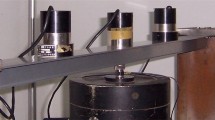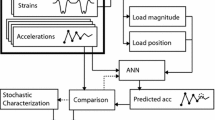Abstract
Large bridge structures are pivotal projects in the transportation system and play a crucial role in social life. With the frequent occurrence of bridge accidents, people are paying more and more attention to the safety of bridge structures. However, existing bridge structure damage identification methods have problems such as low recognition accuracy, high damage localization error rate, and poor recognition effect. In response to the appeal issue, this article used data processing methods based on static test data to denoise and clean the experimental data re-collected from static test data, and obtained effective bridge structural damage data. With the help of these data and backpropagation (BP) neural network, a bridge structural damage identification pattern was constructed. Using this pattern to identify bridge structural damage can effectively address the issues of low identification accuracy and high damage localization error rate. Through experiments, it can be found that the recognition pattern based on BP neural network had an accuracy of over 92.16%, 93.44%, and 94.13% for extracting displacement, strain, and deflection of bridges, respectively. The average recognition accuracy was 95.038%, 94.696%, and 95.27%, respectively. Using static test data and BP neural network to construct a bridge structural damage identification pattern can effectively improve the accuracy of bridge structural damage identification and reduce the error rate of identification and positioning.








Similar content being viewed by others
Data availability
The datasets generated during and/or analyzed during the current study are not publicly available due to sensitivity and data use agreement.
References
Chen D, Li T, Peng K, Zhang K, Lin J, Bai W (2018) Damage identification of bridge structures based on damage performance function. J Chongqing Jiaotong Univ 37(10):1–7
Dang HV, Raza M, Nguyen TV, Bui-Tien T, Nguyen HX (2021) Deep learning-based detection of structural damage using time-series data. Struct Infrastruct Eng 17(11):1474–1493
Delgadillo RM, Casas JR (2020) Non-modal vibration-based methods for bridge damage identification. Struct Infrastruct Eng 16(4):676–697
Fallahian M, Ahmadi E, Khoshnoudian F (2022) A structural damage detection algorithm based on discrete wavelet transform and ensemble pattern recognition models. J Civ Struct Heal Monit 12(2):323–338
Gao Y, Mosalam KM (2018) Deep transfer learning for image-based structural damage recognition. Comput Aided Civ Infrastruct Eng 33(9):748–768
Gordan M, Sabbagh-Yazdi SR, Ismail Z, Ghaedi K, Hamad Ghayeb H (2021) Data mining-based structural damage identification of composite bridge using support vector machine. J AI Data Mining 9(4):415–423
Gouravaraju S, Narayan J, Sauer RA, Gautam SS (2023) A Bayesian regularization-backpropagation neural network model for peeling computations. J Adhes 99(1):92–115
Guo Q, Feng L, Zhang R, Yin H (2020) Study of damage identification for bridges based on deep belief network. Adv Struct Eng 23(8):1562–1572
Guo X, Barrett TD, Wang ZM, Lvovsky AI (2021) Backpropagation through nonlinear units for the all-optical training of neural networks. Photonics Res 9(3):B71–B80
He H, Wei W, Lei H (2020) Intelligent identification of bridge damage based on convolutional neural network and recursive graph. J Basic Sci Eng 28(4):966–980
Jin J, Fu L, Chen Y, Ye L (2020) Research on damage identification of bridge structures based on static virtual deformation method. J Zhejiang Univ Technol 48(5):549–556
Kang JS, Chung K, Hong EJ (2021) Multimedia knowledge-based bridge health monitoring using digital twin. Multimed Tools Appl 80(26–27):34609–34624
Li X, Sun H, Song T, Zhang T, Meng Q (2022) A method of underwater bridge structure damage detection method based on a lightweight deep convolutional network. IET Image Proc 16(14):3893–3909
Li S, Xin J, Jiang Y, Wang C, Zhou J, Yang X (2023) Temperature-induced deflection separation based on bridge deflection data using the TVFEMD-PE-KLD method. J Civ Struct Health Monit 13(2–3):781–797
Lu P, Pan J, Hong T, Li D, Chen Y (2020) Prediction method of bridge static deformation based on dynamic test. Struct Concr 21(6):2533–2548
Lv Z, Qiao L, Cai K, Wang Q (2020) Big data analysis technology for electric vehicle networks in smart cities. IEEE Trans Intell Transp Syst 22(3):1807–1816
Mousavi AA, Zhang C, Masri SF, Gholipour G (2022) Structural damage detection method based on the complete ensemble empirical mode decomposition with adaptive noise: a model steel truss bridge case study. Struct Health Monit 21(3):887–912
Ravand H (2020) Data transmission security module of distributed system based on network coding. Distrib Process Syst. 1(4):41–48. https://doi.org/10.38007/DPS.2020.010406
Schaffer AL, Dobbins TA, Pearson S-A (2021) Interrupted time series analysis using autoregressive integrated moving average (ARIMA) models: a guide for evaluating large-scale health interventions. BMC Med Res Methodol 21(1):1–12
Shang Z, Sun L, Xia Y, Zhang W (2021) Vibration-based damage detection for bridges by deep convolutional denoising autoencoder. Struct Health Monit 20(4):1880–1903
Sinaga HDE, Irawati N (2018) Perbandingan double moving average dengan double exponential smoothing pada peramalan bahan medis habis pakai. J Teknol Dan Sist Inform 4(2):197–204
Wright LG, Onodera T, Stein MM, Wang T, Schachter DT, Hu Z et al (2022) Deep physical neural networks trained with backpropagation. Nature 601(7894):549–555
Yang J, Zhang L, Li R, He Y, Jiang S, Zou J (2020) Research on bridge structural damage identification using joint convolutional and long short memory neural networks. J Railw Sci Eng 17(8):1893–1902
Ye XW, Jin T, Yun CB (2019) A review on deep learning-based structural health monitoring of civil infrastructures. Smart Struct Syst 24(5):567–585
Yu S, Jian Zhang J (2020) Fast bridge deflection monitoring through an improved feature tracing algorithm. Comput Aided Civ Infrastruct Eng 35(3):292–302
Funding
No funding was used to support this study.
Author information
Authors and Affiliations
Corresponding author
Ethics declarations
Conflict of interest
The authors declare that there is no conflict of interest with any financial organizations regarding the material reported in this manuscript.
Rights and permissions
Springer Nature or its licensor (e.g. a society or other partner) holds exclusive rights to this article under a publishing agreement with the author(s) or other rightsholder(s); author self-archiving of the accepted manuscript version of this article is solely governed by the terms of such publishing agreement and applicable law.
About this article
Cite this article
Chen, Y., Liu, R. & Zheng, S. Identification and Diagnosis of Bridge Structural Damage Based on Static Test Data. Iran J Sci Technol Trans Civ Eng (2024). https://doi.org/10.1007/s40996-024-01381-1
Received:
Accepted:
Published:
DOI: https://doi.org/10.1007/s40996-024-01381-1




